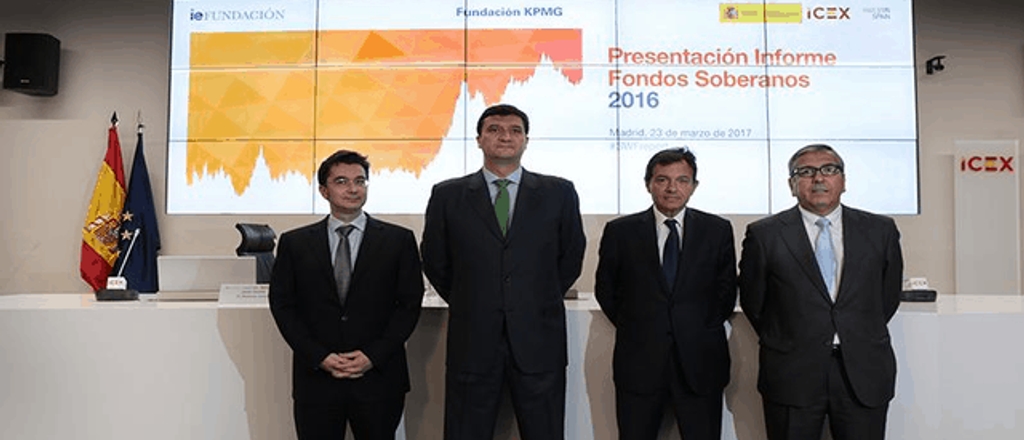- Home
- News And Events
- What’s Going On
- Real Estate And Technology Assets Are The Investment Priorities For Sovereign Wealth Funds
Real Estate and Technology assets are the investment priorities for sovereign wealth funds

Real estate deals doubled to 48, with the hotel sub-sector being particularly vigorous with $7.1 billion in SWF investment, led by the Qatar Investment Authority as its most active investor. Meanwhile, there were another 51 deals in the technology sector, mainly channelled through sovereign venture funds. By contrast, the commodities and natural resources sector was less attractive to the funds, largely due to low oil prices. Another sector which drew less interest was the luxury industry where Qatari investment also predominates.
These are some of the conclusions of “Sovereign Wealth Funds 2016” report prepared by IE BUSINESS SCHOOL, KPMG in Spain and ICEX España Exportación e Inversiones and which looks at these investment vehicles’ performance and the market's main trends in 2015 and the first half of 2016. The report was presented on Thursday by Francisco Javier Garzón, CEO of ICEX, Fernando García Ferrer, Head of Private Equity at KPMG in Europe, the Middle East and Africa (EMA), and Javier Santiso, Chairman of the Sovereign Wealth Lab at IE Business School.
The report examines in detail the profile and features of these investment vehicles, which already manage joint assets worth $7.2 trillion. It underlines their diversity in size, geography and age. There are some large consolidated funds: the top ten, each with more than $200 billion under management, account for 73% of total assets. The Norwegian fund remains at the top of the ranking, with $920 billion. However, most funds do not reach $20 billion.
In terms of geography, 56 countries have set up SWFs, although there are four main areas by volume of assets under management: the Middle East, China, Norway and Southeast Asia. There is also significant dispersion in terms of age, but the average is very young as 66 new funds have been set up since 2000, compared with 28 before the new millennium.
“Spain has an open, sustainable and balanced economy that is attracting renewed interest from international investors with a rise in direct foreign investment in recent years,” argues Francisco Javier Garzón, CEO of ICEX. “In this positive environment SWFs have also increased their positions in Spain in recent years. These funds’ deals are becoming more numerous, are increasing in volume and are becoming increasingly diversified from the sector point of view.”
In 2015, 180 SWF deals were registered, representing a 30% increase over 2014, and in the first half of 2016 about 100 were identified. Although the number of deals has increased, their overall amount has been significantly reduced, largely reflecting the fact that SWFs are investing in higher value assets but to do this they are sharing their exposure with other partners. This is particularly evident in the case of the real estate sector, where more than half of the deals carried out by SWFs in 2015 were in the form of co-investment with other partners.
“There is greater interaction between SWFs and other investment funds,” says Fernando García Ferrer, Head of Private Equity at KPMG in Europe, the Middle East and Africa (EMA). “This is the case in the private equity sector, where we are seeing how SWFs are directly injecting capital into private equity funds or joining with them to make direct acquisitions under co-investment.”
The main change in investment strategy is greater exposure to private markets and the decision to make further investments in innovation and new technology
One of the report’s most salient findings is that the impact of falling oil prices has not been very significant in the short term for the vast majority of the funds. However, in the medium and long term these low prices might have a considerable impact on SWF operations. Their investment strategies are adapting to this new situation in three main ways: greater internal asset management, redefinition of their relations with external managers and an increase in investments in private markets such as real estate and infrastructure.
“The main change in investment strategy is exposure to private markets,” notes Javier Capapé, Director of the Sovereign Wealth Lab at IE Business School and one of the report’s writers. “In fact, real assets (real estate, infrastructure, etc.) already account for 29% of the funds’ portfolios.”
Another prominent trend is SWFs’ growing interest in innovation and technology. According to the report, sovereign venture funds are SWFs with a comprehensive investment strategy in start-ups and venture capital. More and more funds are involved (from Singapore to China and from Malaysia to France) and they are becoming increasingly sophisticated, entering into start-up investment rounds ever earlier. This sector is dominated by Singapore’s Temasek and GIC and the Saudi Arabian Public Investment Fund with its strategic alliance with SoftBank to set up the world’s biggest technology investment fund valued at $100 billion.
Download the full report.